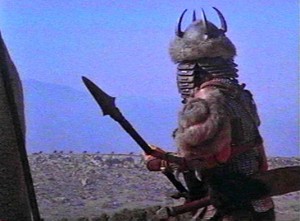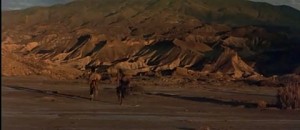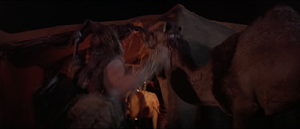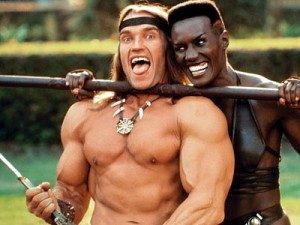 “Between the time when the oceans drank Atlantis, and the rise of the sons of Aryas, there was an age undreamed of. And unto this, Conan, destined to wear the jeweled crown of Aquilonia upon a troubled brow…”
“Between the time when the oceans drank Atlantis, and the rise of the sons of Aryas, there was an age undreamed of. And unto this, Conan, destined to wear the jeweled crown of Aquilonia upon a troubled brow…”
Those words, spoken by the late, great, Makoto Iwamatsu -more commonly known to American audiences as simply “Mako”- probably form many modern American’s first memory of Robert E. Howard’s Hyborian Age, a “prehistoric” world where magic was real, science was dead, and the sons of Aryas (whomever they are) “rose” to eventually usher humanity onto that long trek towards modern history. For most of my generation -even many REH purists (myself included)- John Milius’s Conan: The Barbarian remains the standard for sword and sorcery filmmaking, the bar that no other movie in that subgenre of fantasy has ever even come close to reaching.
This summer (and just in time for my birthday…), Hollywood takes another crack at it with the Marcus Nispel helmed …Conan: The Barbarian.
I know very little about this new film, other than that it was shot in Bulgaria, and the guy playing Conan -Jason Momoa aka Game of Throne‘s Khal Drogo- at least looks more like the “Conan” of Robert E. Howard’s stories than Arnold Schwarzenegger ever did (though that’s not saying much). The trailers, too, at least look promising… but that’s the point of trailers anyway.
They’re not shooting in front of green screens, is the important thing, at least not entirely. They went to some country I had to Google Map to find, built their sets and shot on location. That at least gives me some hope that they know what they’re doing: they got that part right.
In the fantasy genre of filmmaking -with the noted exception of modern urban fantasy of course- it seems the first and most important thing you have to do is find a place to film that your primary audience has never seen before. Fortunately for American filmmakers, most of their audience never travels abroad -only about 20% of Americans own passports- so this probably informs a studio’s decisions (as much as tax breaks), when it comes to finding the appropriate venue for their genre epics -as opposed to, say, just filming in Death Valley.
Nowadays, it seems like if you’re not filming in New Zealand (The Lord of the Rings trilogy, the Star Wars prequels, The Hobbit), or Ireland (Game of Thrones), then you’re doing something wrong -or you’re in a film studio in front of a green screen (Star Wars prequels, again). But in the early 80s, it seemed the place to be to tell your sagas of prehistoric swords and sorcery was… Spain (with a stopover in Vancouver, British Columbia).
Today, anyone familiar with the Hyborian Age of Robert E. Howard’s short stories would probably have a hard time reconciling what they saw on screen in ’82 with what was described in the actual stories. The variety of vistas described in original “Weird Tales” yarns like “The Frost Giant’s Daughter,” “The Queen of the Black Coast,” “Red Nails” and “Beyond the Black River” ranged from snow capped peaks to steaming jungles to endless deserts to brooding forests (hell, “Red Nails” alone has all of those save the snow). Howard’s Hyborian Age was a majestic, expansive prehistoric landscape liberally dotted with sprawling, overcrowded cities and quaint little hamlets. The technology level of Howard’s Hyborians varied by nation, but on average was roughly equivalent to what Medieval Europe would enjoy, with a slight dash of Renaissance even (plate armor, for example). But in John Milius’s 1982 adaptation, most of what we see are men in furs, women in… less, and desert.
…Lots and lots of desert.
…And cities that would not look at all out of place in a Mad Max remake.
When you add to that this whole “Riddle of Steel” thing going on, a “secret” an ancient Atlantean wizard is willing to kill for, you have to wonder if everything these Hyborians make isn’t just made out of bone, bronze, and luck (with the exception of the Cimmerians, who are clearly seen forging steel at the beginning of the movie… and who all die a horrible death 15 minutes in).
The landscapes were certainly thematic though. Nothing says “desolation” and “God is dead” more than a trek through seemingly endless desert landscapes and forbidding arid canyons. This is a movie where the hero “quotes” Genghis Khan for crying out.
http://youtu.be/6PQ6335puOc
There was nothing at all reassuring or safe about the Hyborian Age, even in Howard’s work, and Milius’s movie was all about grabbing you by the throat and ramming all that bluntness and cynicism down your throat in a way that was (at the time) largely unique to Howard’s fantasies, as opposed to the pastoral reassuring fictions (and eventually, via Peter Jackson, New Zealand-esque landscapes) of Middle Earth. The Hyborian Age was not supposed to be beautiful. It was, at its best, majestic but indifferent. Frodo Baggins wouldn’t survive ten minutes in Conan’s world, and neither would any of his friends. They would have been fed to the wolves way ahead of Subotai.
In light of the popularity of The Lord of the Rings, even back then -and this long before Peter Jackson’s blockbuster films- one might think the filmmakers of Conan were almost overcompensating a bit.
But to be fair concerning whatever “inaccuracies” arose between Milius’s film and Howard’s original stories, the only other regular exposure an American might have had to the Hyborian Age before 1982 were the pastiche prose works of L. Sprague de Camp, Lin Carter, and Robert Jordan, as well as the Marvel comics largely written and/or adapted (liberally) by Roy Thomas (often drawing inspiration from the aforementioned pastiches, unrelated fantasy properties and even the superhero Marvel Universe). By the early 80s the actual works of Robert E. Howard himself -and just REH- were slightly more difficult to come by then they are today -no exhaustive collections or omnibuses were in print, no Borders or Barnes & Nobles or Amazon existed, there wasn’t even an Internet where you could just Google image anything. So a lot of the “mistakes” that were made that would infuriate Howard purists today (and it’s a huge list) simply didn’t matter: there simply weren’t that many purists around to piss off. And the landscapes weren’t “inaccurate” so much as they just seemed singularly barren. And lest we forget, Milius’s landscapes and costumes weren’t the only thing to suffer from revisionism. Even today, with REH’s works enjoying something of a modern day pop culture renaissance via the aforementioned collections, action figures, and obsessively accurate Dark Horse comic book adaptations, most American’s first image of Conan (and by the way, it’s pronounced like the comedian’s name, not “Koh-nan”) is still Arnold Schwarzenegger -a light haired Austrian bodybuilder who could barely string two words of dialog together for the entirety of the film, not at all like the black haired, blue eyed, but intellectual psuedo-Celtic reaver that the original stories (and even the comics and pastiches) depicted.
Simply put, in 1982, the important thing wasn’t getting the Hyborian Age to look “right,” it was simply about getting it to look different, and foreboding, and most importantly, inhospitable. The Hyborian continent was a harsh land that bred harsh people. Howard’s protagonists were gunslingers in a time before guns, where everyone who wasn’t armed with a length of steel was just another victim. Post Lord of the Rings, we now have no less than three epic fantasy movies set in Middle Earth (New Zealand), and for the first time we have a generation that can grow up viewing Rings and Conan side by side. But where Jackson’s movies act almost like a travel guide -and actually were for at least a few people I knew, who suddenly got very interested in going to New Zealand after viewing those films, much like what Braveheart did to Scotland- Milius’s swords and sorcery epic seemed more like a huge “Keep Out” sign (albeit with way better music). In the end, for all the orcs and talking trees, you might want to live in Jackson’s Middle Earth, but you’d be an idiot to want to live in Milius’s Hyborian Age.
And it worked. At least for me. I was immersed as much as I was repelled. Meanwhile, I have yet to meet even the most diehard fan who so loved Conan: The Barbarian’s scenic vistas that they traveled to Spain just to view them first hand. I personally loved my visit to Milius’s world, but I wouldn’t want to live there. If you’re not getting chased by wolves you’re getting pecked at by vultures. Why the hell would anyone ever want to go there?
The makers of Barbarian have since tried to replicate this magic no less than three times, once with a direct Conan sequel -1984’s Conan: The Destroyer- once with a spin-off featuring another sword slinger cutting their way through the Hyborian Age -1985’s Red Sonja- and, more recently in ’97, with Kevin Sorbo as Kull the Conqueror (actually an adaptation of what would have been the third Conan movie: Conan: The Conqueror). These films didn’t work as well -at least not critically, and Red Sonja and Kull were straight flops- because, frankly, while the filmmakers kept to the same visual style, they seemed determined to just let the scenery do all the talking while the characters engaged in more light hearted slapstick. Red Sonja in particular looked like it was filmed on just the other side of Thulsa Doom’s Mountain of Power (it wasn’t, Sonja was shot in Italy), but in the end, like Destroyer and Kull, the film was too campy and light; it disengaged the audience to the point where they couldn’t forgive, this time, the horrid acting of the leads or the admittedly gaudy costumes the players were supposed to wear to blend in with their “prehistoric” landscape. As odd as it might sound, Conan: The Barbarian worked for exactly the reason the latter three failed: because it took itself seriously. In Barbarian, there was a visual link via the landscapes and sets and costumes with the dialog and action, and it all added up to reinforce the story’s main themes of despair, indifference, and irrational cruelty. For the next three films they tried to sell fantasy epics with charming heroes who would have fit right in with Frodo and company (if Conan’s clique were better actors at least). The themes were lighter and the distinction between “good” and “evil” obvious to the point of pandering. The contrast was simply too jarring.
There’s a lesson to be learned from Milius’s turn at Conan: The Barbarian. And despite what the purists say it has very little to do with visual fidelity to Howard’s stories. The lesson is simply this: the Hyborian Age is not for you. Conan’s world is not a world you enjoy, it’s a gauntlet that you (barely, maybe, probably won’t) survive. Howard’s world, as presented -faithfully- by John Milius, is not a reassuring escapist fantasy of good’s triumph over evil, it’s a character study of the human psyche writ large, a place where kill or be killed is the only moral standard, and like the foreboding landscapes and decadent, filthy cities, you’re probably not going to like what you see -but they couldn’t care less.
In 2011, we’ll be presented with yet another interpretation of the Hyborian Age, one that looks, at least from the trailers, more crowded, slightly more civilized and settled, more green and vibrant… and very CGIrific. I’m certainly not going to complain about a few more trees or CGI effects, and I welcome Nispel’s visual contrast of civilization versus barbarity (because to be fair, if everyone looks “barbaric,” as they did in ’82’s Conan, then why was Conan singled out as one?); but I will be watching to see how the landscape is treated. Is it a beautiful, bountiful land to be protected from the Forces of Evil? Or is it an indifferent bitch that’s only there to soak up the blood of the fallen? I sincerely hope for the latter. I sincerely hope that Mr. Nispel, in trying to stay faithful to REH’s vision, also kept Mr. Milius’s “other” Hyborian Age vision in mind.








